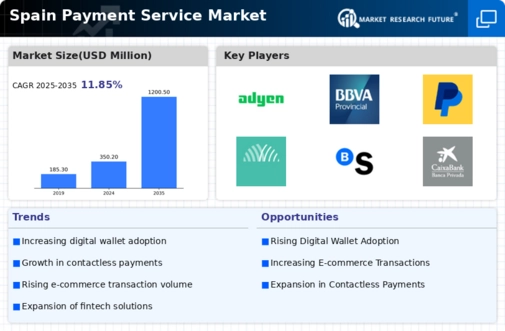Rise of Mobile Banking
The proliferation of mobile banking applications is significantly impacting the payment service market in Spain. With an increasing number of consumers utilizing smartphones for financial transactions, mobile banking is becoming a preferred method for managing finances. In 2025, it is projected that over 60% of the Spanish population will engage in mobile banking, leading to a corresponding rise in mobile payment solutions. This shift necessitates that payment service providers develop user-friendly mobile interfaces and secure transaction processes. Furthermore, the integration of mobile banking with other financial services, such as investment and budgeting tools, presents opportunities for growth within the payment service market.
Increasing E-commerce Adoption
The surge in e-commerce activities in Spain is a pivotal driver for the payment service market. As consumers increasingly prefer online shopping, the demand for efficient and secure payment solutions rises. In 2025, e-commerce sales in Spain are projected to reach approximately €50 billion, indicating a growth rate of around 15% from the previous year. This trend compels payment service providers to innovate and enhance their offerings, ensuring seamless transactions. The integration of various payment methods, including credit cards, digital wallets, and buy-now-pay-later options, is essential to cater to diverse consumer preferences. Consequently, the payment service market must adapt to these evolving consumer behaviors to remain competitive and relevant.
Consumer Demand for Convenience
The growing consumer expectation for convenience is a crucial driver in the payment service market. Spanish consumers increasingly seek quick and hassle-free payment options, which influences their choice of payment methods. In 2025, surveys indicate that approximately 70% of consumers prefer payment solutions that offer instant transactions and minimal friction. This trend encourages payment service providers to streamline their processes, reduce transaction times, and enhance user experiences. Additionally, the rise of subscription services and recurring payments further emphasizes the need for convenient payment solutions. As a result, the payment service market must continuously evolve to meet these consumer demands and preferences.
Regulatory Changes and Compliance
Regulatory changes are shaping the landscape of the payment service market in Spain. The implementation of new regulations aimed at enhancing consumer protection and data security is influencing how payment service providers operate. In 2025, compliance with the European Union's Payment Services Directive 2 (PSD2) is critical for all payment service providers, as it mandates stronger customer authentication and transparency in transactions. This regulatory environment encourages innovation while ensuring that consumer rights are upheld. As payment service providers navigate these regulatory frameworks, they must adapt their services to remain compliant, which could potentially lead to increased operational costs but also fosters consumer trust in the payment service market.
Technological Advancements in Payment Solutions
Technological innovations are transforming the payment service market in Spain. The adoption of contactless payments, mobile payment applications, and blockchain technology is reshaping how transactions are conducted. In 2025, it is estimated that contactless payments will account for over 40% of all transactions in Spain, reflecting a significant shift towards convenience and speed. Furthermore, advancements in artificial intelligence and machine learning are enhancing fraud detection and risk management, thereby increasing consumer trust in digital transactions. As technology continues to evolve, payment service providers must invest in research and development to stay ahead of the curve and meet the demands of tech-savvy consumers.






















Leave a Comment